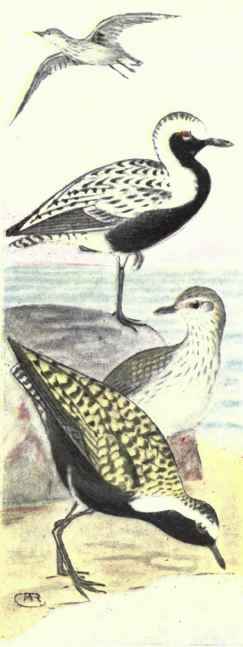271. European Golden Plover. Charadrius Apricarius
Description
This section is from the book "The Bird Book", by Chester A. Reed. Also available from Amazon: The Bird Book.
271. European Golden Plover. Charadrius Apricarius
A European bird, similar to the next, casually-found in Greenland.
It is a very abundant bird throughout Europe, breeding in the northern parts. Its habits, nests and eggs are the same as those of the American bird.
272. Golden Plover. Charadrius Dominions Dominicus
Range. - Whole of North America, breeding in the Arctic regions and wintering south to Patagonia.

Black-bellied Plover. Golden Plover.

Greenish buff.
This handsome bird is about the same size as the Black-bellied Plover (10.5 inches long). No hind toe. Back and tail mottled with black and yellow; below, more or less entirely black to the tail. Young and winter adults, more or less spotted with yellow and blackish-brown above, and grayish-white below, with indistinct streaks on the breast. Often confused with the last species in this plumage, but is smaller, bill smaller and more slender, and the axillars, or feathers nearest the body, under the wings, are gray while those of the Black-bellied Plover are black. This species is now regarded as rare on the North Atlantic coast during migrations, while in the interior it is more abundant than the last species. They do not seem to be as suspicious as the Black-bellies, and a flock will often allow a close approach, even when they see you. They nest abundantly along the coast and islands of the Arctic Ocean. The four eggs are very similar to those of the preceding, but smaller. Size 1.90 x 1.30. Data. - Peel River, Arctic America, June 1, 1898. Nest of grasses and leaves on the ground in the moss.
272a. Pacific Golden Plover. Charadrius Dominicus Fulvus
Range. - An Asiatic species, breeding in northern Asia and on the islands and coast of Asia. Very like the preceding, but more golden color on the back and wings. Nesting and eggs the same.

Continue to:


